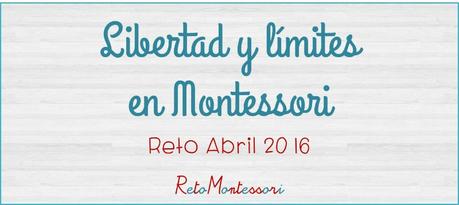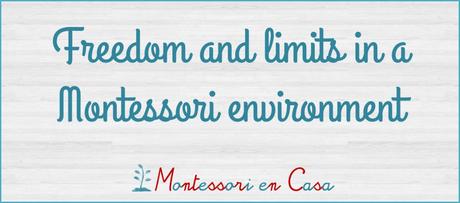(scroll down for English)
Libertad y límites en Montessori es el tema que vamos a tratar este mes en RetoMontessori. Por si no sabéis en qué consiste RetoMontessori os cuento: Cada mes (normalmente el último martes del mes), voy a publicar un post sobre un tema de filosofía Montessori o relacionado con la pedagogía Montessori, que será el tema que trabajaremos durante el mes siguiente en RetoMontessori. Este post estará en el blog a disposición de todo el mundo.
Tres días después del post, es decir, el viernes de esa misma semana, expondré el tema con más detalle en un webinar y los asistentes podrán participar planteando preguntas, compartiendo sus ideas, debatiendo, etc, algo que creo que va a ser muy interesante y enriquecedor! Para asistir a estos webinars mensuales es necesario unirse a RetoMontessori, aquí os explico cómo hacerlo.
No quiero enrollarme más sobre el funcionamiento de RetoMontessori para no extenderme mucho, pero si tenéis cualquier duda ya sabéis que podéis dejarme un comentario al final de este post o contactarme por email.
Después de esta intro, vamos al tema:


Libertad y límites en Montessori, no sé cuantísimas veces me han preguntado sobre este tema... Cuando empiezas a leer o escuchar cosas sobre Montessori pero todavía no has profundizado mucho te suele surgir una de estas dos preguntas:
¿Pero en Montessori los niños hacen lo que les da la gana? ¿Pero Montessori no es muy estricto porque hay que seguir un montón de normas?Como veis son dos visiones diametralmente opuestas, y ninguna de las dos es cierta. En Montessori los niños tienen libertad, pero no hacen lo que "les da la gana", porque también tienen límites. Y no, no hay que seguir un montón de normas, se trata de pocas normas pero muy claras y de sentido común; los niños entienden que respetar esas normas es necesario para respetar a sus compañeros, al entorno y a ellos mismos.
Maria Montessori decía que libertad y disciplina son dos caras de una misma moneda; no puedes tener una sin la otra. Y creo que dio en el clavo. Todos sabemos lo que pasa cuando tenemos libertad sin disciplina, verdad? Algo parecido al caos. Y también tenemos una idea bastante clara de lo que es tener disciplina sin libertad, no? Podríamos llamarlo represión. No queremos ninguna de esas dos opciones, así que nos toca buscar el equilibrio entre libertad y disciplina, o libertad y límites, y no os asustéis porque no es tan difícil como parece.
Seguro que habéis escuchado más de una vez que los niños necesitan límites porque les dan seguridad. Los adultos también los necesitamos, pero en el caso de los niños pequeños todavía necesitan que los límites los establezca otra persona, y a medida que van creciendo van siendo capaces de establecer también sus propios límites.
Y ahora viene la pregunta del millón:
¿Cómo encontrar el equilibrio entre libertad y límites?
En un ambiente Montessori hay una manera muy clara de mantener el equilibrio entre libertad y límites; el Ciclo de trabajo en 3 periodos:
- Puedes elegir cualquier material que ya se te haya presentado y que esté disponible.
- Puedes trabajar con el material elegido todo el tiempo que quieras (durante el periodo de trabajo de 3 horas) siempre que le des un uso adecuado.
- Cuando termines, debes devolver el material a su lugar tal y como lo encontraste.
Al leer en qué consisten los tres periodos ¿veis claramente dónde está la libertad? ¿Y los limites? Si os fijáis no se utiliza la palabra "no" en ningún momento, los límites están tan integrados dentro de la libertad que no es necesario exponerlos en forma de sermón para que los niños los entiendan.
Tal vez el ciclo de trabajo en 3 periodos no sea aplicable en nuestro entorno familiar, pero una vez que entendemos las claves que hacen que esto funcione las podremos llevar a cualquier contexto. Veamos esas tres claves:
- Los límites nos son arbitrarios, tienen sentido y podemos explicar fácilmente a un niño que un límite está ahí por seguridad o por respeto. Tal vez los más pequeños no lo entiendan al principio, pero ahí entra la siguiente clave:
- Las normas o límites son iguales para todos, incluidos los adultos. Si los niños ven que todos respetamos las mismas normas entenderán que ellos también deben respetarlas.
- Al exponer los límites en positivo damos la información de lo que sí se puede hacer y obviamos todo lo que no se puede hacer, por ejemplo: "Sólo estamos de pie en el suelo" en vez de "No nos ponemos de pie en la mesa", No nos ponemos de pie en el sofá", "No nos ponemos de pie en la cama"...
¿Cómo lo veis? En la teoría suena fácil, otra cosa es la práctica, ¿verdad? Por eso éste va a ser nuestro reto de Abril, tenéis todo un mes para llevar esta teoría a vuestra vida real, y por supuesto espero que me contéis vuestras experiencias en los comentarios!
A los miembros de RetoMontessori os espero el viernes en el webinar para hablar más a fondo de este tema, ver ejemplos prácticos y resolver las preguntas que tengáis.


-----


Freedom and limits in a Montessori environment, I don't t know how many times I have been asked about this topic... When you start reading or hearing about Montessori but you have not delved much you usually find yourself asking one of these two questions:
But... in Montessori children do whatever they want?But... Isn't Montessori very strict because you have to follow a lot of rules?
As you can see they are two diametrically opposed visions, and neither is true. In Montessori children have freedom, but they do not do "whatever they want" because they also have limits. And no, they don't have to follow a lot of rules, there are very few and clear rules and tehy come from common sense; children understand that respecting these rules is necessary in rder to respect their peers, the environment and themselves.
Maria Montessori said that freedom and discipline are two sides of the same coin; you can not have one without the other. And I think she nailed it (once again). We all know what happens when we have freedom without discipline, right? Something like chaos. And we also have a pretty good idea of what it is to have discipline without freedom, no? We could call it repression. We do not want either of those options, so we have to find the balance between freedom and discipline, or freedom and limits, and don't panic because it is not as difficult as it seems.
Surely you have heard more than once that children need limits because they give them security. Adults also need them, but in the case of young children they still need the limits to be set for them by another person, and as they grow they will also be able to set their own limits.
And now comes the million dollar question:
How to find the balance between freedom and limits?
In a Montessori environment there is a very clear way to keep the balance between freedom and limits; the 3-part work cycle:
- You can choose any material that has been introduced to you and is available.
- You can work with the material of choice as long as you want (during the working period of 3 hours) as long as you give proper use.
- When finished, you must return the material to its place as you found it.
After reading about these 3 parts of the work cycle, do you see clearly where freedom is? And the limits? Yo have probably seen that the word "no" is not used at any time, the limits are so integrated into the freedom that is not necessary to expose them to the children as a sermon.
Perhaps the 3-part work cycle is not applicable in our family environment, but once you understand the keys that make this work you can use them any context. Let's look at these three keys:
- The limits are not arbitrary; they have meaning and can be easily explained to a child that a limit is there for safety or respect. Perhaps the youngest kids will not understand at first, but there comes the following key:
- Rules or limits are the same for everyone, including adults. If children see that we all respect the same rules they will understand that they too must respect them.
- By explaining the limits with positive phrasing we give information of what can be done and we exclude everything that cannot be done, for example: "We only stand on the floor" instead of "We do not stand up on the table", "We do not stand up on the couch", "We do not stand up on the bed"...
How does this sound to you? In theory it sounds easy, another thing is practice, right ? So this will be our challenge for April, you have this whole month to tkate this theory to your real life, and of course I hope you tell me your experiences in the comments!
(Visited 562 times, 1 visits today)

